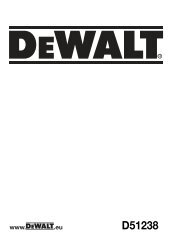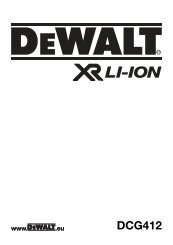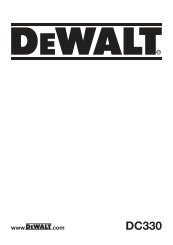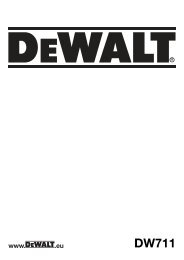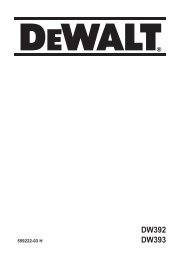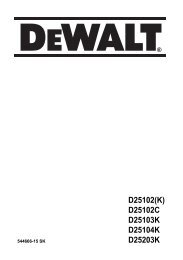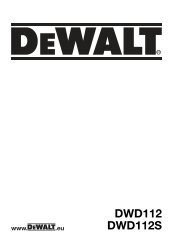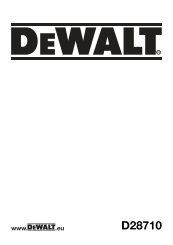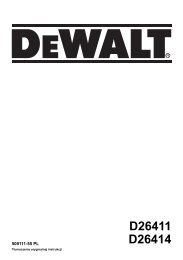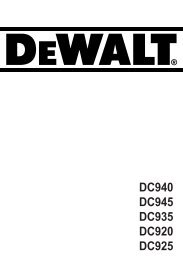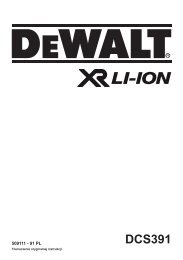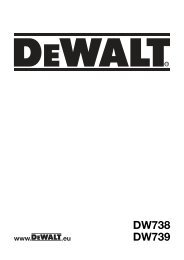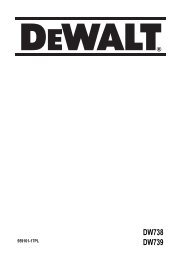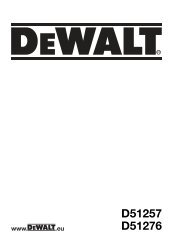Australia - New Zealand - Service - DeWALT
Australia - New Zealand - Service - DeWALT
Australia - New Zealand - Service - DeWALT
Create successful ePaper yourself
Turn your PDF publications into a flip-book with our unique Google optimized e-Paper software.
• Replacement of the supply cord. If the supply cord is damaged, it must be<br />
replaced by the manufacturer or an authorised DEWALT <strong>Service</strong> Centre in order<br />
to avoid a hazard.<br />
Extension Cords<br />
CAUTION: Use only extension cords that are approved by the country’s Electrical<br />
Authority. Before using extension cords, inspect them for loose or exposed wires,<br />
damaged insulation and defective fittings. Replace the cord if necessary.<br />
MINIMUM GAUGE FOR CORD SETS<br />
For Cable length (m): 7.5 15 25 30 45 60<br />
Use Cable with minimum rating (Amperes)<br />
Tool Amperes<br />
0 - 3.4 7.5 7.5 7.5 7.5 7.5 7.5<br />
3.5 - 5.0 7.5 7.5 7.5 7.5 10 15<br />
5.1 - 7.0 10 10 10 10 15 15<br />
7.1 - 12.0 15 15 15 15 20 20<br />
12.1 - 20.0 20 20 20 20 25 –<br />
Drill/Driver/Hammerdrill Safety Warnings<br />
• Wear ear protectors with impact drills. Exposure to noise can cause hearing<br />
loss.<br />
• Hold power tools by insulated gripping surfaces when performing an<br />
operation where the cutting tool may contact hidden wiring or its own cord.<br />
Contact with a “live” wire will make exposed metal parts of the tool “live” and<br />
shock the operator.<br />
• Use clamps or other practical way to secure and support the workpiece to a<br />
stable platform. Holding the work by hand or against your body is unstable and<br />
may lead to loss of control.<br />
• Wear ear protectors when hammering for extended periods of time. Prolonged<br />
exposure to high intensity noise can cause hearing loss. Temporary hearing loss<br />
or serious ear drum damage may result from high sound levels generated by<br />
hammerdrilling.<br />
• Wear safety goggles or other eye protection. Hammering and drilling operations<br />
cause chips to fly. Flying particles can cause permanent eye damage.<br />
3<br />
• Hammer bits and tools get hot during operation. Wear gloves when touching<br />
them.<br />
• Air vents often cover moving parts and should be avoided. Loose clothes,<br />
jewellery or long hair can be caught in moving parts.<br />
WARNING: ALWAYS use safety glasses. Everyday eyeglasses are NOT safety<br />
glasses. Also use face or dust mask if<br />
cutting operation is dusty. ALWAYS WEAR CERTIFIED SAFETY EQUIPMENT:<br />
• ANSI Z87.1 eye protection (CAN/CSA Z94.3),<br />
• ANSI S12.6 (S3.19) hearing protection,<br />
• NIOSH/OSHA/MSHA respiratory protection.<br />
WARNING: Some dust created by power sanding, sawing, grinding, drilling, and<br />
other construction activities contains chemicals known to cause cancer, birth defects<br />
or other reproductive harm. Some examples of these chemicals are:<br />
• lead from lead-based paints,<br />
• crystalline silica from bricks and cement and other masonry products, and<br />
• arsenic and chromium from chemically-treated lumber (CCA).<br />
Your risk from these exposures varies, depending on how often you do this type of<br />
work. To reduce your exposure to these chemicals: work in a well ventilated area, and<br />
work with approved safety equipment, such as those dust masks that are specially<br />
designed to filter out microscopic particles.<br />
• Avoid prolonged contact with dust from power sanding, sawing, grinding,<br />
drilling, and other construction activities. Wear protective clothing and wash<br />
exposed areas with soap and water. Allowing dust to get into your mouth, eyes,<br />
or lay on the skin may promote absorption of harmful chemicals.<br />
WARNING: Use of this tool can generate and/or disburse dust, which may cause<br />
serious and permanent respiratory or other injury. Always use NIOSH/OSHA approved<br />
respiratory protection appropriate for the dust exposure. Direct particles away from<br />
face and body.<br />
WARNING: ALWAYS wear proper personal hearing protection that conforms to<br />
ANSI S12.6 (S3.19) during use. Under some conditions and duration of use, noise<br />
from this product may contribute to hearing loss.<br />
CAUTION: When not in use, place tool on its side on a stable surface where it<br />
will not cause a tripping or falling hazard. Some tools with large battery packs will<br />
stand upright on the battery pack but may be easily knocked over.



